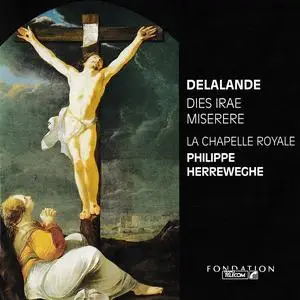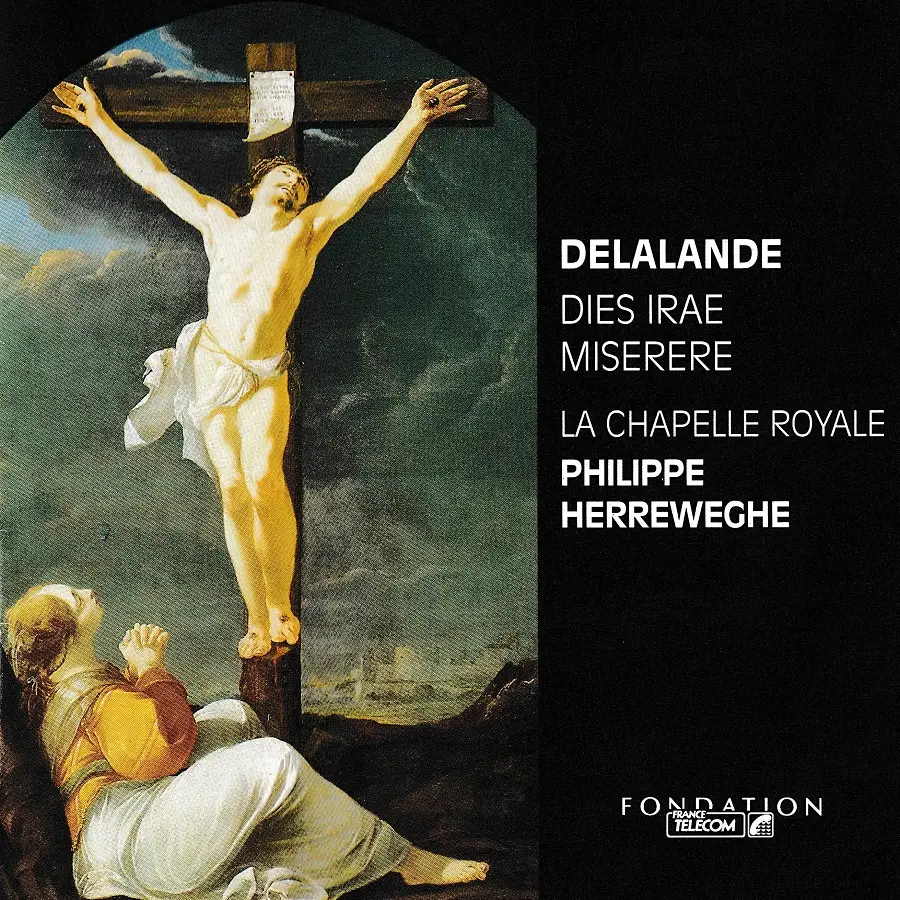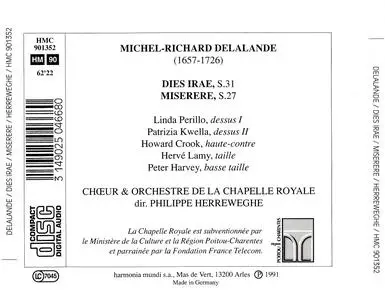Philippe Herreweghe, La Chapelle Royale - Michel-Richard de Lalande: Dies Irae, Miserere (1991)
EAC | FLAC | Image (Cue & Log) ~ 300 Mb | Total time: 62:22 | Scans included
Classical | Label: Harmonia mundi | # HMC 901352 | Recorded: 1990
EAC | FLAC | Image (Cue & Log) ~ 300 Mb | Total time: 62:22 | Scans included
Classical | Label: Harmonia mundi | # HMC 901352 | Recorded: 1990
Originally composed for the funeral of the dauphine, Princess Marie-Anne-Christine-Victoire of Bavaria, on May 1, 1690, this remarkable setting of Dies irae was revised in 1711, either because of the dauphin's death, or that of Lalande's two daughters, both distinguished sopranos ; all died from smallpox within a period of six weeks. Lully's setting of Dies irae, for the death of the queen in 1683, had shown the possibilities of this text as a grand motet for soloists, choirs and orchestra. But it was Lalande, seven years later, who developed the concept, and produced a much more striking result - perhaps the first setting of Dies irae in the history of music where the composer exploited in such dramatic style the contrasts inherent in the 18 rhyming stanzas and final couplet of this 13th-century poem. This work ably demonstrates Lalande's penchant for the more reflective and sombre, calling forth an impressive musical response. His strong formal sense is shown in the musical design which is organised so as to group the 18 stanzas in four groups each of four, framing a central group of two. The two larger groups nearer the centre are each assigned to a solo voice (haute-contre, then baritone) while the others employ a variety of solo and choral textures.
The composer employs a wide variety of musical resource with which to adorn these structures. The traditional plainsong, sung by the chorus sopranos, marks both the opening Dies irae and the concluding Pie Jesu, in each case introduced by a web of counterpoint of awesome beauty. Stark moments, such as Quantus tremor and Mors stupebit are portrayed in homophonic outbursts punctuated by silences, while the drama of Tuba mirum is declaimed by the baritone to a background of rapidly repeated chords in the orchestra, a device increasingly used by the composer and his contemporaries to denote death, fear, storm, the sea, and other dramatic phenomena. Harmonic sequences of great intensity underline the passionate texts of Quid sum miser and Lacrimosa, descending melodic leaps characterize the fervent pleading of Oro supplex, while an impressive alternation of grand choeur a 5 and high-voice petit choeur a 3, depict a dramatic Confutatis maledictis and a passionate Voca me cum benedictis. Altogether, such imaginative treatment of this text was highly original and a landmark in baroque sacred music.
The only extant source of the work forms part of the private library of M Robert Lutz of Strasbourg. This copy, reflecting the revised version, and dated 1739, is in the usual eighteenth-century form of partition reduite, lacking the three viola parts, but these have been newly reconstituted by the present editor. The manuscript retains the names of the original cast of 1690, all celebrated court singers of the time. The sopranos were the famous castrati, "Antonio" [Bagniera] and Antonio Favalli, and the falsetto Jean-Baptiste Matho (the deceased dauphine's singing teacher), the hautes-contre Jean Jonquet l'aine and Charles Dumoussel, the tenor Gatien Courcier, the baritones Jacques Bastaron and Antoine Maurel (Morel) and the bass, Jacques d'Estival. Of these, the most colourful was Bagniera. Born in Switzerland in 1638, and son of a Swiss Guard at the court of Louis XIV, he was an outstanding boy singer in the choir of the royal chapel. After an operation which scandalised the king, Bagniera became the doyen of the chapel castrati until the age of 82 ; in retirement, he survived to the age of 102 ! Possessed of a voice notable for its "prodigious volume" and "extreme beauty", he was also, sadly, "endowed with the most grotesque body" (from the memoirs of another chapel singer, Marc-Francois Beche).
Of all Lalande's motets, his Miserere settings attracted most attention from his contemporaries. Alexandre Tannevot wrote, in 1728 : "What expressiveness is lavished on most of his solos ! And who cannot fail to be moved when he hears the Sacrificium Deo… the Amplius lava me…". In 1754, the Abbe Laugier asked : "Can one… ever express more affectingly the deep pain of a penitent soul, than in the Sacrificium Deo of [Lalande's] Miserere ? No one has pushed further the art of melody and its accompaniment… his choruses are usually most happily conceived… when they are well-performed, the effect is astonishing." The earliest of Lalande's several versions of the Miserere, his first grand motet setting (Philidor MSS, Ms. Mus. 8, Bibl. mun. de Versailles), was his response to a text made famous by Lully's version, so admired by Louis XIV. Composed in 1687, the same year the despotic Surintendant had died, was it a tribute to him, despite all he had done to frustrate the young Lalande's career ? Later, towards 1700, Lalande adapted the work, completely rewriting some sections, while omitting alternate movements so as to employ plainchant alternating to produce a Miserere a voix seule. Later still, nearer 1720, he made a thorough revision of the earlier grand motet, employing some of the changes made for the petit motet, and substantially rewriting the remainder (Cauvin MSS, Ms mus 219, Bibl. mun. de Versailles); this is the version recorded here.
This, the most substantial of all his grands motets, like several of the composer's most impressive works (including the Dies irae), is in the key of C minor. The work opens with the tripartite design used in several of Lalande's motets where the same thematic material is shared by an opening prelude, a solo recit (in this case, for soprano) and a grand choeur. Many poignant and expressive moments are assigned to solo voices, giving the composer freer rein to add melismas and ornamentation to the vocal line and to the instrumental obbligati, and, as we have seen, it is these movements which attracted the enthusiastic approval of the composer's contemporaries. The ostinato structures of the soprano solos, Amplius lava me and Asperges me hyssopo may be noted, as must be the heroic writing for haute-contre in Redde mihi and especially in Domine, labia mea. The final recit, Sacrificium Deo, for baritone, is distinguished by its introduction of 24 bars for full orchestra, which accompanies the soloist throughout this powerfully expressive movement. Of the choruses, one must admire not only the "hidden things of wisdom" a deux choeurs, the expressive brevity of Averte faciem tuam, and the linear strength of Docebo iniquos. but also the remarkable tour deforce of the finale, its frenzied orchestral accompaniment without parallel in the entire output of the composer.–Lionel Sawkins
Performer:
Linda Perillo (dessus I)
Patrizia Kwella (dessus II)
Howard Crook (haute-contre)
Hervé Lamy (taille)
Peter Harvey (basse taille)
Chœur & Orchestre de la Chapelle Royale
Philippe Herreweghe, direction
Tracklist:
Michel-Richard de Lalande (1657-1726)
DIES IRAE, S.31
01. Dies irae (chœur : sopranos)
02. Quantus tremor (chœur)
03. Tuba mirum (baryion)
04. Mors stupebit (chœur)
05. Liber scriptus (haute-contre)
06. Recordare Jesu pie (trios & chœur)
07. Quaerens me (duo sopranos)
08. Justejudex (baryton)
09. Inter oves ( trios & chœur)
10. Oro supplex (soprano)
11. Lacrimosa dies illa (trio)
12. Pie Jesu Domine (chœur)
MISERERE MEI, DEUS, S.27
13. Miserere mei, Deus (soprano & chœur)
14. Amplius lava me (soprano)
15. Tibi soli peccavi (baryton & chœur)
16. Ecce enim in iniquitatibus (trio)
17. Ecce enim veritatem (2 chœurs)
18. Asperges me (soprano)
19. Averte faciem tuam (chœur)
20. Cor mundum (quatuor)
21. Ne projicias me (haute-conre)
22. Docebo iniquos (chœur)
23. Libera me (baryton)
24. Domine, labia mea (haute-contre)
25. Quoniam si voluisses (chœur)
26. Sacrificium Deo (baryton)
27. Benigne fac (chœur)
Exact Audio Copy V1.3 from 2. September 2016
EAC extraction logfile from 16. April 2019, 17:34
Philippe Herreweghe / de Lalande - Dies Irae, Miserere
Used drive : HL-DT-STDVDRAM GP65NW60 Adapter: 1 ID: 0
Read mode : Secure
Utilize accurate stream : Yes
Defeat audio cache : Yes
Make use of C2 pointers : No
Read offset correction : 6
Overread into Lead-In and Lead-Out : No
Fill up missing offset samples with silence : Yes
Delete leading and trailing silent blocks : No
Null samples used in CRC calculations : Yes
Used interface : Native Win32 interface for Win NT & 2000
Used output format : User Defined Encoder
Selected bitrate : 1024 kBit/s
Quality : High
Add ID3 tag : No
Command line compressor : C:\Program Files (x86)\Exact Audio Copy\FLAC\FLAC.EXE
Additional command line options : -6 -V -T "ARTIST=%artist%" -T "TITLE=%title%" -T "ALBUM=%albumtitle%" -T "DATE=%year%" -T "TRACKNUMBER=%tracknr%" -T "GENRE=%genre%" -T "COMMENT=%comment%" -T "BAND=%albuminterpret%" -T "ALBUMARTIST=%albuminterpret%" -T "COMPOSER=%composer%" %haslyrics%–tag-from-file=LYRICS="%lyricsfile%"%haslyrics% -T "DISCNUMBER=%cdnumber%" -T "TOTALDISCS=%totalcds%" -T "TOTALTRACKS=%numtracks%" %hascover%–picture="%coverfile%"%hascover% %source% -o %dest%
TOC of the extracted CD
Track | Start | Length | Start sector | End sector
––––––––––––––––––––––––––––-
1 | 0:00.32 | 1:20.05 | 32 | 6036
2 | 1:20.37 | 1:06.60 | 6037 | 11046
3 | 2:27.22 | 1:26.45 | 11047 | 17541
4 | 3:53.67 | 1:22.48 | 17542 | 23739
5 | 5:16.40 | 3:02.17 | 23740 | 37406
6 | 8:18.57 | 2:10.68 | 37407 | 47224
7 | 10:29.50 | 2:56.02 | 47225 | 60426
8 | 13:25.52 | 3:32.00 | 60427 | 76326
9 | 16:57.52 | 2:20.63 | 76327 | 86889
10 | 19:18.40 | 1:36.32 | 86890 | 94121
11 | 20:54.72 | 2:47.05 | 94122 | 106651
12 | 23:42.02 | 4:18.10 | 106652 | 126011
13 | 28:00.12 | 4:05.35 | 126012 | 144421
14 | 32:05.47 | 2:31.08 | 144422 | 155754
15 | 34:36.55 | 2:11.15 | 155755 | 165594
16 | 36:47.70 | 1:24.07 | 165595 | 171901
17 | 38:12.02 | 1:36.38 | 171902 | 179139
18 | 39:48.40 | 3:59.55 | 179140 | 197119
19 | 43:48.20 | 1:11.57 | 197120 | 202501
20 | 45:00.02 | 1:38.05 | 202502 | 209856
21 | 46:38.07 | 3:17.58 | 209857 | 224689
22 | 49:55.65 | 1:30.20 | 224690 | 231459
23 | 51:26.10 | 1:52.20 | 231460 | 239879
24 | 53:18.30 | 2:27.00 | 239880 | 250904
25 | 55:45.30 | 0:48.27 | 250905 | 254531
26 | 56:33.57 | 3:23.13 | 254532 | 269769
27 | 59:56.70 | 3:25.50 | 269770 | 285194
Range status and errors
Selected range
Filename C:\Users\Grant\Desktop\Philippe Herreweghe - de Lalande - Dies Irae, Miserere.wav
Peak level 90.4 %
Extraction speed 2.1 X
Range quality 100.0 %
Test CRC F921317A
Copy CRC F921317A
Copy OK
No errors occurred
AccurateRip summary
Track 1 accurately ripped (confidence 21) [C0AC1205] (AR v2)
Track 2 accurately ripped (confidence 21) [DDE53C2F] (AR v2)
Track 3 accurately ripped (confidence 21) [AF8B4A6C] (AR v2)
Track 4 accurately ripped (confidence 21) [1604CF59] (AR v2)
Track 5 accurately ripped (confidence 20) [6959DCFD] (AR v2)
Track 6 accurately ripped (confidence 21) [112E74C2] (AR v2)
Track 7 accurately ripped (confidence 21) [FC5200B3] (AR v2)
Track 8 accurately ripped (confidence 21) [7AC4434F] (AR v2)
Track 9 accurately ripped (confidence 21) [2F05D863] (AR v2)
Track 10 accurately ripped (confidence 21) [02B0A5BB] (AR v2)
Track 11 accurately ripped (confidence 21) [648A1C2A] (AR v2)
Track 12 accurately ripped (confidence 21) [F373CD2C] (AR v2)
Track 13 accurately ripped (confidence 21) [2EEA63CB] (AR v2)
Track 14 accurately ripped (confidence 21) [FCA50B9E] (AR v2)
Track 15 accurately ripped (confidence 21) [136C7715] (AR v2)
Track 16 accurately ripped (confidence 21) [253BF83D] (AR v2)
Track 17 accurately ripped (confidence 21) [16DE3873] (AR v2)
Track 18 accurately ripped (confidence 21) [14A0EF20] (AR v2)
Track 19 accurately ripped (confidence 20) [8D3CD0BA] (AR v2)
Track 20 accurately ripped (confidence 20) [1FC66113] (AR v2)
Track 21 accurately ripped (confidence 21) [5D24007E] (AR v2)
Track 22 accurately ripped (confidence 21) [CEC47BF9] (AR v2)
Track 23 accurately ripped (confidence 21) [C52B4AF5] (AR v2)
Track 24 accurately ripped (confidence 21) [C0FD833C] (AR v2)
Track 25 accurately ripped (confidence 21) [0ED6AB6E] (AR v2)
Track 26 accurately ripped (confidence 21) [D5AF597D] (AR v2)
Track 27 accurately ripped (confidence 20) [6BED8007] (AR v2)
All tracks accurately ripped
End of status report
–– CUETools DB Plugin V2.1.6
[CTDB TOCID: FjjrdYKoakVXeyhhNeg.oJ8fM_s-] found
Submit result: FjjrdYKoakVXeyhhNeg.oJ8fM_s- has been confirmed
Track | CTDB Status
1 | (19/19) Accurately ripped
2 | (19/19) Accurately ripped
3 | (19/19) Accurately ripped
4 | (19/19) Accurately ripped
5 | (19/19) Accurately ripped
6 | (19/19) Accurately ripped
7 | (19/19) Accurately ripped
8 | (19/19) Accurately ripped
9 | (19/19) Accurately ripped
10 | (19/19) Accurately ripped
11 | (19/19) Accurately ripped
12 | (19/19) Accurately ripped
13 | (19/19) Accurately ripped
14 | (19/19) Accurately ripped
15 | (19/19) Accurately ripped
16 | (19/19) Accurately ripped
17 | (19/19) Accurately ripped
18 | (19/19) Accurately ripped
19 | (19/19) Accurately ripped
20 | (19/19) Accurately ripped
21 | (19/19) Accurately ripped
22 | (19/19) Accurately ripped
23 | (19/19) Accurately ripped
24 | (18/19) Accurately ripped
25 | (19/19) Accurately ripped
26 | (19/19) Accurately ripped
27 | (17/19) Accurately ripped, or (1/19) differs in 9819 samples @03:18:21-03:18:22,03:18:42,03:18:62-03:18:63,03:19:07-03:19:08,03:19:28-03:19:29,03:19:48-03:19:49,03:19:69,03:20:14-03:20:15,03:20:34-03:20:35,03:20:55-03:20:56,03:21:00-03:21:01,03:21:20-03:21:22,03:21:41-03:21:42,03:21:61-03:21:62,03:22:07-03:22:08,03:22:27-03:22:28,03:22:47-03:22:49,03:22:68-03:22:69,03:23:13-03:23:14,03:23:34-03:23:35,03:23:54-03:23:55,03:23:74-03:24:00,03:24:20-03:24:21,03:24:40-03:24:41,03:24:61-03:24:62,03:25:06-03:25:07,03:25:26-03:25:28,03:25:47-03:25:48
==== Log checksum B0FD15124F0DD5A097FC58910FE8F077A694F0AC948CA013F4427371D424DB23 ====
Thanks to the original releaser





